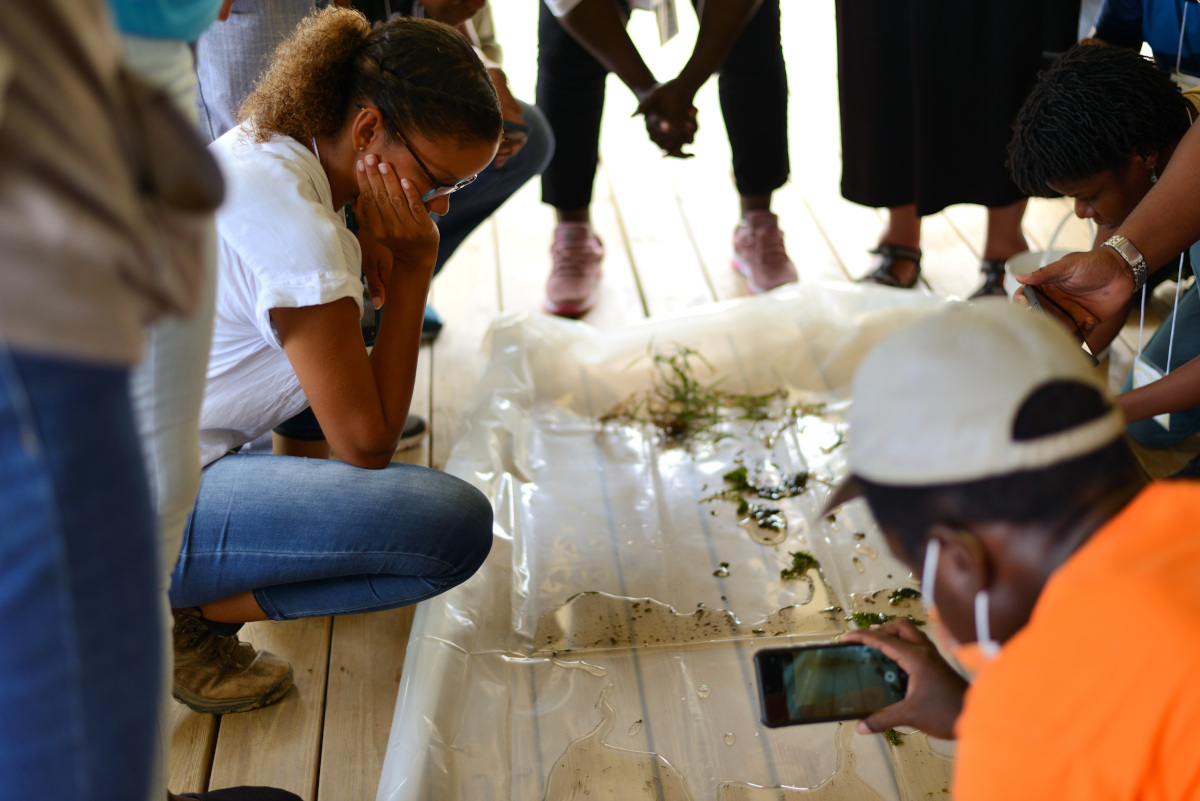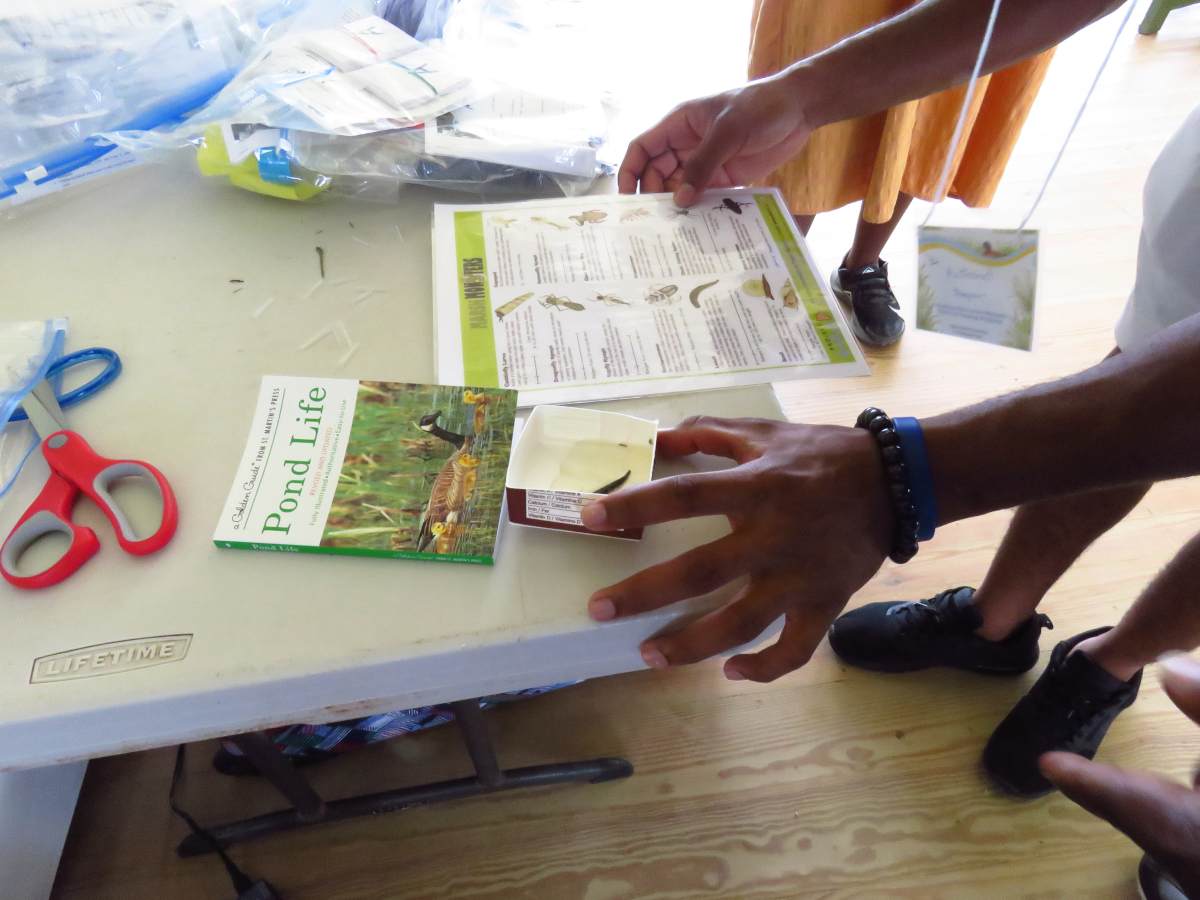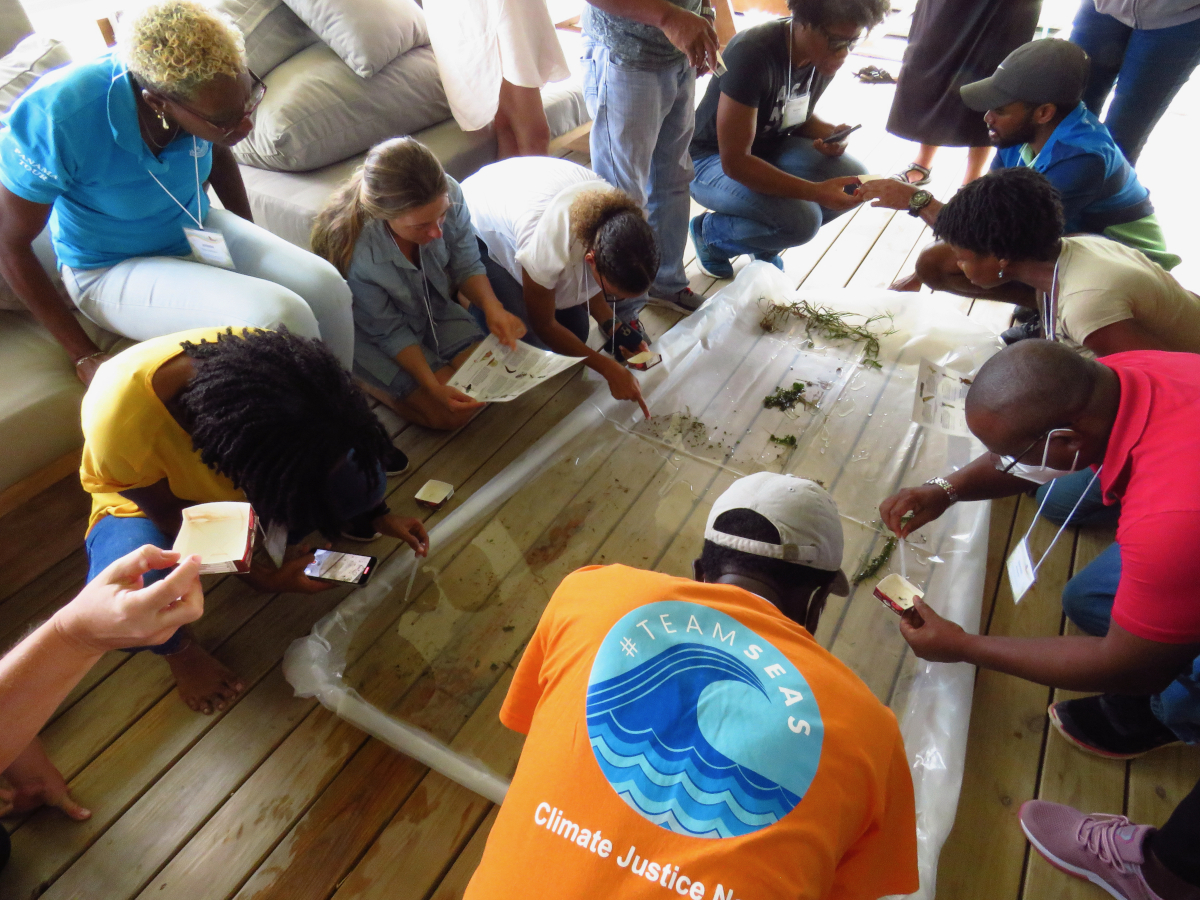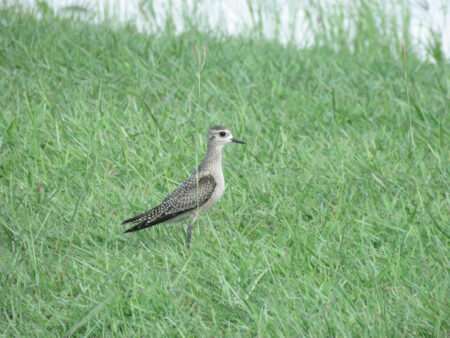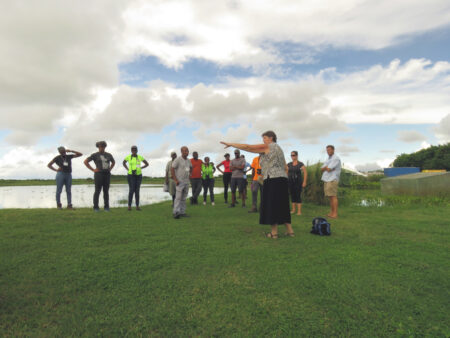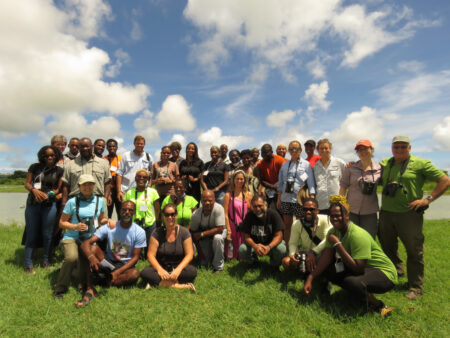
With bird migration in full swing September was the perfect time for BirdsCaribbean to head to Barbados for a Wetlands Education Training Workshop! From September 27-28, 2022 30 participants took part in this ‘train the trainers’ event at Walkers Reserve, where they learned all about the wondrous wetlands and wetland birds on Barbados. During the two days of fun-filled and hands-on learning, participants were armed with tools, resources, and inspiration to help them share what they learned with others. Read all about what the workshop was like from the perspective of workshop participant Meike Joseph.
In September I completed a two-day Wetlands and Bird Education Training Workshop held by BirdsCaribbean at Walkers Reserve, Barbados. Initially, when I found out about this workshop, I got excited. I see birds on a regular basis but have not been able to identify them. So now you know why I joined this workshop – I wanted to learn how to identify birds. As it turned out I learnt so much more than that! Considering that this workshop was just two days, the information was extremely useful for my field of work. I did not feel overwhelmed at any point. The facilitators made learning easy, explaining all aspects of each topic in its simplest form so we could easily understand and absorb the information.
Talking about wetlands
On the first day of the workshop we were given a substantial amount of learning materials including bird identification charts, colouring books, and a book, Wondrous West Indian Wetlands: Teachers’ Resource Book, which is packed with information on Caribbean wetlands and birds, including many educational activities that can be done with kids and communities. We were also given a pop quiz as soon as registration was completed. Needless to say, I panicked as I didn’t know much about birds or wetlands! However, this quiz was helpful. As we did the same quiz at the end of the two-day period, it allowed the facilitators and myself to see how much we had learned, and it was a lot!
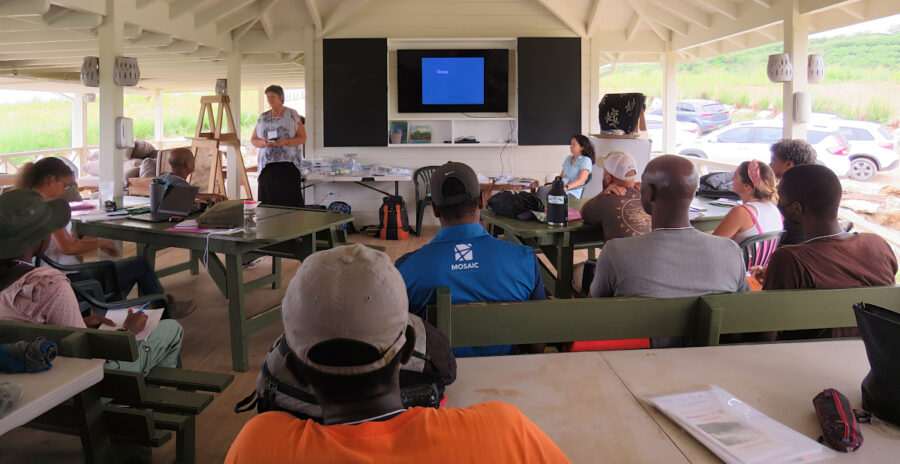
Marvelous mangroves
We gained a significant amount of knowledge on wetlands, including definitions of wetlands and what we would find within these amazing ecosystems, with a focus on mangroves. This intrigued me as I am very passionate about them. We received a booklet on Mangroves of the Caribbean which assisted in mangrove identification, and also learnt about how important they are as homes and protection for all kinds of birds, fish, crustaceans and other organisms.
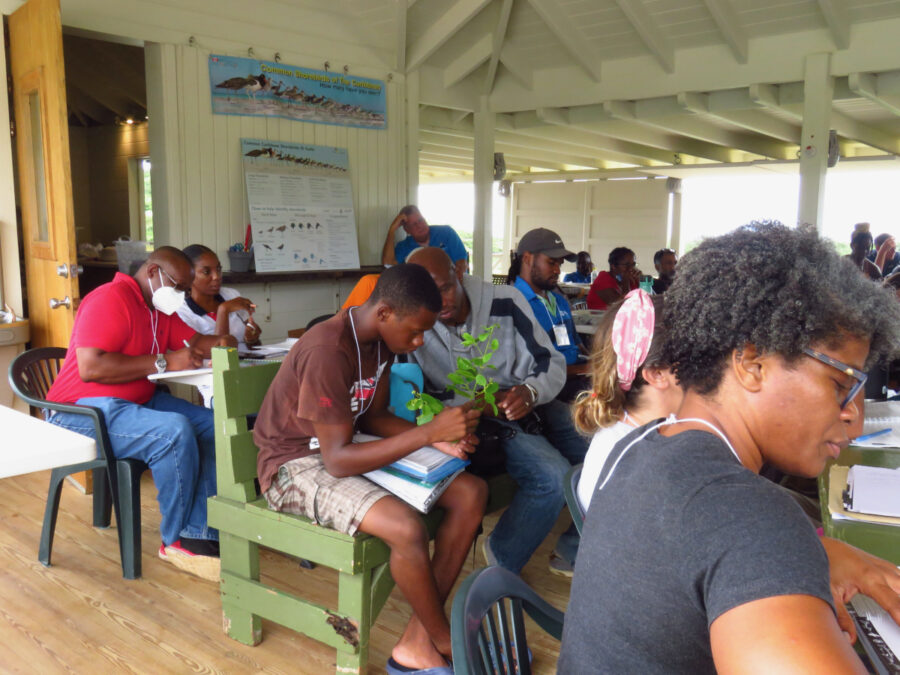
Pouring a pond!
We then participated in a demonstration titled Pour-a-Pond (Activity 2-C in Wondrous West Indian Wetlands). This was the highlight of the first day for me. We made a small pond-like structure from a sheet of plastic which was filled with water from the ponds at Walkers Reserve. We were then asked to catch and identify the various organisms that we spotted in the water, using an identification chart that was given to us by Dr. Sorenson and Ms. Kading. This activity resulted in lots of interaction between the students who were all fascinated by the many organisms they found. After this demonstration, we learned a lot about the importance and value of our wetlands, the ongoing destruction of these unique ecosystems, and why we should make efforts to save them.
Next, John Webster, an experienced birder and bird guide in Barbados gave an excellent presentation on Wetlands in Barbados and the many resident and migratory birds that use these sites. I found this riveting! I am a local person, but I had never seen or heard about some of these locations. John pointed out that many of these wetland areas were once used for bird shooting but some are now becoming conservation areas.
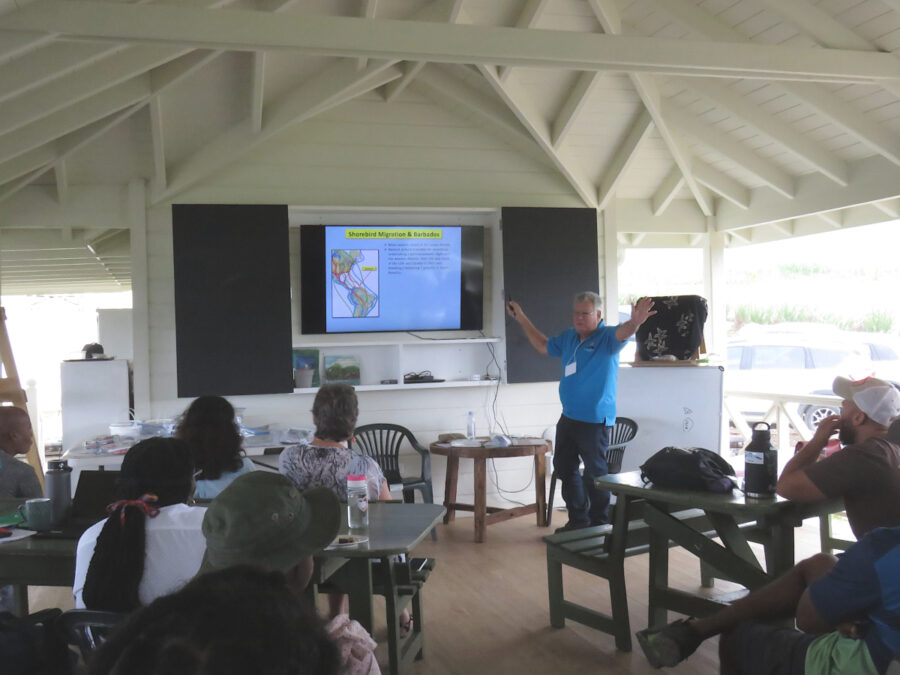
Time to get active
At noon, we separated into six groups to partake in different activities from the workbook. We then demonstrated them to the other participants. The title of my group’s activity was ‘Salty Currents’ where we gathered materials and used them to show what occurs when fresh and saltwater meet, as they do in swamps. We also discussed how water temperature and salinity influence plant and animal habitats in wetlands. All activities were wetland-and bird-focused and resulted in extensive discussions, and even heated debates!
One such activity, called ‘Difficult Decisions,’ was a role-play where participants in the group discussed real-life environmental issues in a Town Hall setting. Each person took on the role of a different stakeholder, all with different interests in the outcome, for example, debating the fate of a mangrove slated for destruction to make way for a new hotel. The development company, environmental minister, tourism minister, fisherman, eco-tourism guide, local restaurant owner, environmentalist, etc. all have different opinions about whether or not the development should move forward. Each passionately argued their case and voiced their opinion, sometimes sounding like well-known local public figures in similar situations! This brought on laughs but the exercise is valuable in that it places students in the position of decision-makers and challenges them to make up their own minds about what to do.
Another important activity, ‘A Hunter’s Tale,‘ addressed the issue of hunting. This was another role play intended to stimulate students to think about the issue of hunting and make up their own minds about it. Barbados provides important stopover habitats for many migratory shorebirds, however, many of these wetlands are private “shooting swamps” managed for hunting. Hunting has a long history in Barbados and in the past, tens of thousands of shorebirds were killed each fall. Thankfully, some of the “shooting swamps” have been converted into shorebird refuges in recent years, now providing vital habitat for birds like the Lesser Yellowlegs that need a place to rest and feed on their long migrations. These refuges are now wonderful places to see hundreds of shorebirds and waterbirds up close – we were grateful to the hunting clubs that allowed us to visit and enjoy the birds on the field trip the next day!
“There were many highlights to my learning experience at the workshop. It was exciting gaining knowledge on birds but also thrilling to learn about wetlands, particularly the mangroves within them.” – Meike Joseph
Birding 101
Following the peer-teaching activities was a presentation on bird identification. Prior to this presentation, many of us had limited knowledge on identifying birds. We learnt about how to identify birds, including observing size and shape, beak size and curvature, color patterns, behavior, habitat, and more. I found it very interesting that birds change their feather colors or plumage, based on the season – the breeding or non-breeding season. This would sometimes make it tricky to identify some birds! This lesson added to my eagerness to observe birds on Day Two.
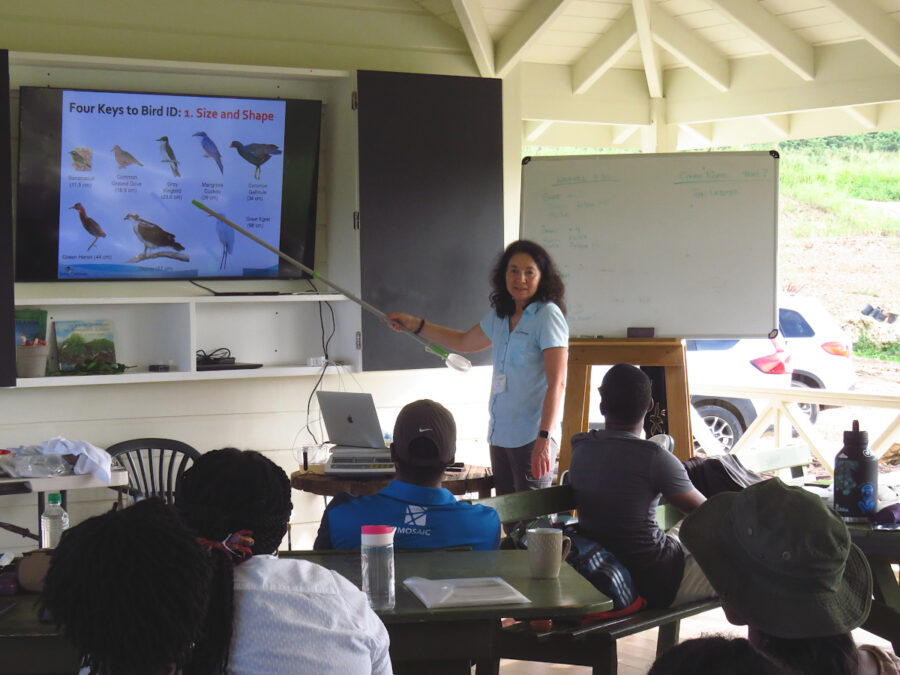
After this presentation, the day ended and we were on our way home, armed with a range of learning materials and a significant amount of knowledge on wetlands and birds.
Day two: On the road we go
Day Two was one of adventure and learning. We headed off to two wetlands to observe and identify the various birds that we saw with our binoculars which had been given, compliments of BirdCaribbean, to be used for continued outreach and education at Walkers Reserve.
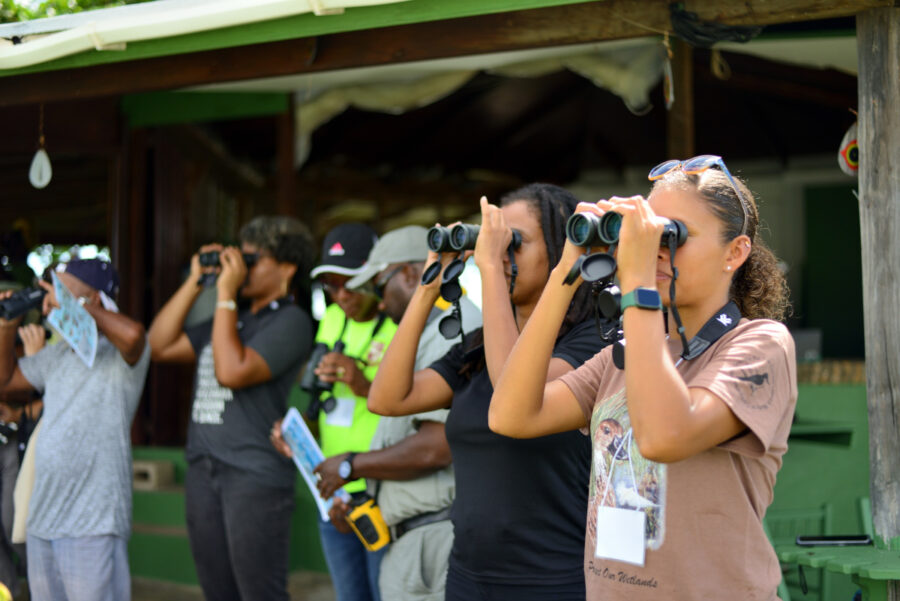
That relaxing feeling when bird watching
Our first site was Congo Road Private Bird Sanctuary, a former shorebird shooting swamp. We focused on observing and identifying all the birds that we saw. Ms. Kading first led an activity called Sound Mapping (Activity 6-J), which I thought was quite calming. It was a highlight for me at this location. We were asked to sit quietly, to listen to all the sounds around us and also to note the direction of these sounds. This made me realize how long it had been since I quieted down and really tuned in to nature’s beautiful sounds. As I was sitting and listening, I also noticed a bird hunting for food in the water, diving to catch its prey – a fascinating sight.
The second place we went to was one that was unfamiliar to me – a beautiful wetland on the north of the island called Foster’s Swamp, another former shooting swamp, turned bird sanctuary, filled with a great variety of birds. It’s here that I was able to observe a unique bird for me, a juvenile American Golden Plover resting on the grass. This was a beautiful and informative day. We used the knowledge gained from Day One to assist in identifying different wetland birds.
Later at Foster’s Swamp the group also took part in several of the fun games and activities from the Wetlands Workbook about migration and food webs. Games played included “Migration Headache” which involved ‘migrating’ (running) from breeding areas to increasingly limited wetland habitat (paper plates), learning about the threats faced by migrant birds from habitat loss, pollution, hunting and hurricanes. In “Deadly Links” the participants playing the role of ‘Ospreys’ caused havoc amongst their hapless ‘prey’ – only to discover that they had consumed so many pesticides (accumulated in the food-chain) that their next clutch of eggs wouldn’t hatch. Another intriguing activity was Mangrove Metaphors—learning about the functions and values of mangroves from everyday household objects (e.g., sponge, sieve, cereal box, etc.). Other games involved making a ‘human food web’ and then untangling it, as well as learning about how limited food and habitat resources affect migrating birds in a game called “Habitat Havoc.” Thankfully the weather had cooled during the afternoon and these games got everyone up and active!
Got that Certificate!
The second day of the birding workshop ended with us receiving our certificates stating that we successfully completed the Wondrous West Indian Wetlands Education Training Workshop. Gaining this knowledge on birds was personally satisfying and also assisted me in creating birding tours.
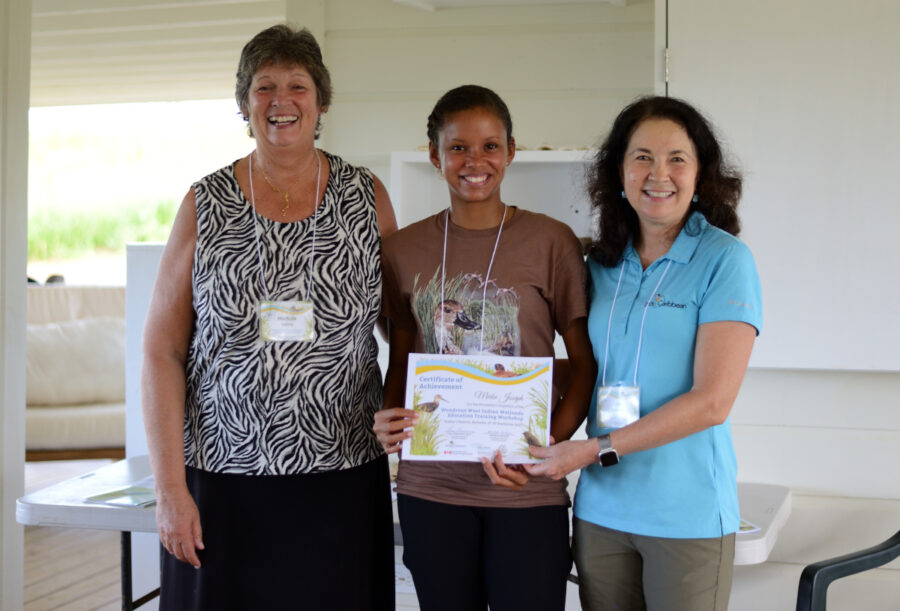
Meieke Joseph is a Project Officer and Tour Manager for Walkers Institute for Regeneration Research Education and Design (WIRRED) and environmental non-profit based at Walkers. Whilst studying at UWI Cave Hill she completed a research project on Remnant Wetlands on the West Coast of Barbados. This has fueled her passion to work on mangrove restoration on the island and has also motivated her to work towards more regenerative practices for Barbados.
This workshop was made possible with funding from Environment and Climate Change Canada, and additional support from Walkers Reserve, WIRRED, CPRI Barbados, Vortex Optics, US Forest Service International Programs, and Southeastern Printing. Thanks also to Congo Road and Fosters Swamp Private Bird Sanctuaries for kindly hosting us on the field trip. You can learn more about the Wonderful West Indian Wetlands project here.
If you want to learn more about shorebirds in the Caribbean check out our shorebird resources page here, which has downloadable ID resources, outreach materials, videos and information pages.

